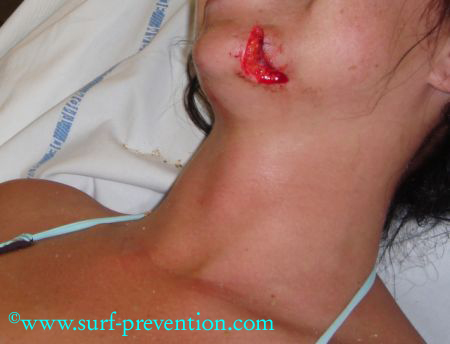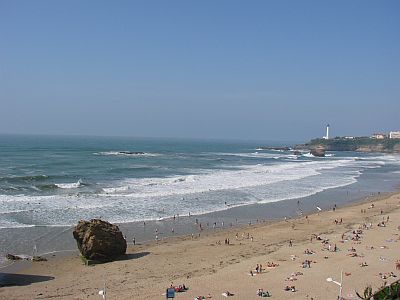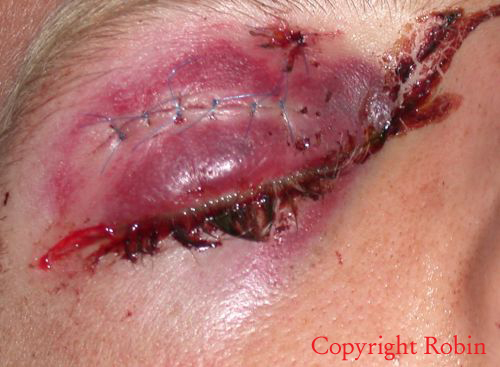Surfing-related accidents: epidemiology and prevention
G. Barucq, O. Jenkins, T. Mokni, S. Marcé, J-M. Campagne, D. Le Jeune.
Centre Hospitalier de la Côte Basque. Bayonne. France.
To read the abstract, click here.
Introduction
Surfing came to France in 1956. In 50 years, this ‘extreme sport’ has undergone a prolific growth : attracting an ever-growing number of youth followers and comprising roughly 200,000 surfers in the country to date. However, democratisation of the sport risks to promote accidents. There does not exist any objective data concerning the accidentology associated with the practice of surfing in France. We have studied in a prospective manner all surfing-related accidents of patients admitted to the Basque Coast’s Emergency Departments during the summer of 2006.
Materials and methods
The sport of surfing consists in maintaining balance whilst riding a board carried by a wave. This study is limited to accidents sustained or provoked by surfers. Our study was carried out across the Basque Coast in the south-west of France. Between the northern beaches of Anglet and the southern beaches of Hendaye, the Basque Coast concentrates 38km of numerous quality surfing spots offering a wide variety of waves favorable to the practice of surfing.
We distributed a ‘Surf-related Accident’ questionnaire, asking each emergency physician of the ‘Centre Hospitalier de la Cote Basque’ and surrounding centres of ‘Clinique Saint-Étienne, Bayonne’, ‘Polyclinique Aguiléra, Biarritz’ and ‘Côte Basque Sud, Saint-Jean-de-Luz’ to complete for all concerned patients between 21st June and 30th September 2006. We crosschecked this information with the telephone calls to the ‘SAMU 64A’ Medical Regulation Centre, registered on computer as « surf-related accident » and with the medical dossiers completed by the Beach Lifeguards.
Results
350 admissions to emergency departments for surf-related accidents were recorded.
Surf-related accidents were more prevalent amongst the youth population with a mean age of 26,2 years affected. 22% of patients were female. 65% of surfers injured were experienced surfers and 35% were beginners (44% of whom were injured during a surfing lesson).
59% of accidents occurred when the surfer made contact with his own board. Collisions represented 17% of accidents : collisions between surfers (66%), between surfer and swimmer (27%) or between surfer and bodyboarder (5%). Surfers were injured against the seabed in 13% of cases.
In 61% of cases, the surfer presented with a laceration. Surfboards caused 93% of lacerations (most often from the sharp edge of a fin or pointed nose of their board). 64% of lacerations required suturing (6 sutures on average) and 15% were stapled (scalp). Lacerations are at risk of infection or cosmetic deformity amongst those surfers who return to the water or who re-expose themselves to the sun prematurely.

The majority of trauma affected the head : 50,9% of cases in total and of these 54% were facial lacerations and 24% scalp lacerations. We encountered 14 cases of nasal fracture, 7 dental traumas and 4 cases of trauma to the tympanic membrane.

Trauma to the lower limb represented 25,7% of cases : 60% of these were lacerations. We observed 10% knee sprains (Medial Collateral Ligament) and 10% ankle sprains (of which a third were severe) among this group.
Upper limb trauma represented 14,6% of cases of which 50% were hand trauma : 4 metacarpal fractures, 8 phalangeal fractures of which 5 were open (provoked by the coiling of a leash around the finger), 2 interphalangeal sprains, 5 lacerations sutured and 5 contusions.

The thorax was involved in 3,5% of cases with a majority of contusions.
The abdomen was affected in 1,1% of cases (contusions caused by board impact).
One testicular laceration and one contusion of the testicles was noted in this series.
Patients sustaining a fracture, dislocation, severe sprain, a laceration requiring at least 8 sutures or necessitating hospitalisation, represented 26% of cases.
We encountered 3 open maxillofacial fractures, 3 severe eye traumas and 3 cervical spine fractures, of which two required neurosurgical intervention.
We only encountered one Stage 1 Drowning : drowning is rare among surfers as their boards buoyancy aids survival.
Discussion
Our study is representative of the accidentology of surfing in waves surrounding overpopulated beaches such as those in certain regions of California or Australia. The risks vary according to the season and beach : in Tahiti or Hawaii, the power of waves and underlying reef allows for a different trauma.
An adaptable material could prevent the majority of accidents. A soft board of size adapted to height is safer for children and beginners. For the users of surfboards made of harder materials (resin, epoxy,… ), it may be necessary to recommend boards of more rounded shape.
We encourage the use of flexible fins and nose protectors. Wetsuits protect from the cold, the sun and also limit the risk of lacerations. Ear plugs can prevent tympanic trauma and exostoses (surfers ear).
It is remarkable that the use of helmets is not advised among surfers given that the proportion of head trauma exceeds 50% according to our study. Actually, a very small minority of surfers wear a helmet which appears to be essential in certain overpopulated spots where there is a large risk of collision and also in waves breaking in very shallow water or over reef.
Conclusion
Surfing is the most accident-prone activity around the beaches of the Basque Coast in summer.
The majority of accidents could be prevented by applying simple measures and with promotion of a campaign of surfer awareness, supported by the French surfing federation and professionals allied to the sector.
It is urgent that we take measures to ensure the safety of the growing number of surfers riding the waves of the French coast.
An observatory for beach accidents could be created, promoting prevention across the population of surfers and other water users, which continues to grow each year with the evolution of materials and the effects of current fashion.
References
(1) Cazin A, Olderr T. Surf. La revue du praticien Médecine Générale. Pathologies de l’été, le Guide 2006. Juin 2006. Tome 20. Numéros 738- 739 : pages 835-836.
(2) Chang SK, Tominaga GT, Wong JH et al. Risk factors for water sports-related cervical spine injuries. J Trauma. 2006 May; 60 (5): 1041-1046.
(3) Cheynet de Beaupre C. Surf : pathologie et traumatologie. Thèse de Médecine n°118. Université Lyon 1. 1991.
(4) Hall G, Benger RS. Missed diagnosis of an intraorbital foreign body of surfboard origin. Ophthalmic Plastic and Reconstructive Surgery. 2004 May ; 20 (3) : 250-2.
(5) Kim JW, McDonald HR, Rubsamen PE et al. Surfing-related ocular injuries. Retina. 1998 ; 18 (5) : 424-9.
(6) Latapy X. Les accidents de plage sur le littoral aquitain, au cours des étés 1999 et 2000. Thèse de Médecine n° 99. Université Victor Segalen Bordeaux 2. 2004.
(7) Nathanson A, Bird S, Dao L, Tam-Sing K. Competitive Surfing Injuries: A Prospective Study of Surfing-Related Injuries among Contest Surfers. Am J Sports Med. 2007 Jan ; 35(1) : 113-7.
(8) Roger P. Injury in the surf. Sport Health. Sports Medicine Australia. September 2002. Volume 20. Issue 2.
(9) Taylor DM, Bennet D, Carter M, Garewal D, Finch C. Perceptions of surfboard riders regarding the need for protective headgear. Wilderness Environ Med. 2005 Summer; 16 (2) : 75-80.
(10) Taylor KS, Zoltan TB, Achar SA. Medical illnesses and injuries encountered during surfing. Curr Sports Med Rep. 2006 Sep ; 5 (5) : 262-7.
(11) Zoltan TB, Taylor KS, Achar SA. Health issues for surfers. American Family Physician. June 15, 2005. Vol 71 (n°12): 2313-2317.















Pas de commentaire
Soyez le premier à laisser un commentaire